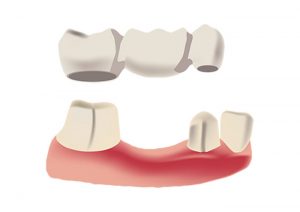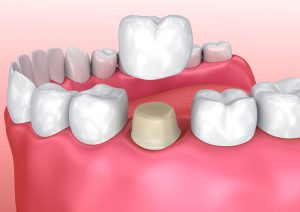Restorative Dentistry in Vancouver
Restorative dentistry services offered by your Vancouver dentist.
Fillings are the most common procedure performed at most dental offices. Lack of proper oral hygiene often leads to decay (cavities). Dental fillings are used to repair the damage created by decay. Fillings restore form and function to the tooth, however, in cases of larger decay or fractures, crowns may be more suited.
We provide a large number of treatment options including fillings, cleanings, root canals, dental implants, crowns, and bridges. Our goal is to meet your dental needs and offer you an enjoyable visit.
Keep reading below for short descriptions of our restorative dentistry services.
Come meet your local Vancouver Dentist
You deserve a happy dental experience, we want to help. Call us today at (604) 423-9383 for our assistance.
Fillings
To treat a cavity we remove the decayed portion of the tooth and then “fill” the area on the tooth where the decayed material once lived. Fillings are also used to repair cracked or broken teeth and teeth that have been worn down from misuse (such as from nail-biting or tooth grinding).
Today, several dental filling materials are available. Teeth can be filled with gold; porcelain; or more commonly, tooth-coloured, plastic and glass materials called composite resin fillings. The location and extent of the decay, cost of filling material, patients’ insurance coverage and our dentist’s recommendation assist in determining the type of filling that will best address your needs.
Root Canals
Extensive decay, tooth trauma, or gum disease can infect the nerve of a tooth causing inflammation or infection that can lead to pain and a dental abscess. During a root canal procedure, the affected nerve and pulp are removed and the inside of the tooth is cleaned and sealed.
A successful root canal treatment lets you keep the tooth rather than having to pull it out. Keeping your tooth helps to prevent your other teeth from drifting out of line and causing jaw problems. It also avoids having to replace it with an artificial tooth. With today’s modern dental techniques, having root canals done by a dentist is no longer a scary experience. Our team is experienced in performing root canal therapy.

Oral Surgery
Some conditions of the mouth require minor surgical procedures to correct the problem. Conditions such as impacted wisdom teeth, dental implants to replace missing teeth and removal of oral lesions can often be performed by our skilled dentists with local anesthetics. If the condition is more complex and beyond the scope of a general dentist, we have a network of board certified Oral Maxillofacial Surgeons that work closely with us to ensure your best care.
Inlays and Onlays
Inlays and onlays restore your teeth beautifully with custom-created porcelain or resin material. They are an aesthetic alternative to fillings and look exactly like the rest of your natural tooth. Inlays and onlays protect and restore large portions of the decayed tooth, much like a large filling.
Inlays fill the tooth in between cusps, while onlays lay over the chewing surface of your tooth. We often recommend inlays and onlays because they are one of the highest quality options available. They preserve tooth structure, and are more durable than some of our other choices.
The procedure:
Restoring your teeth with inlays or onlays take two appointments. On your first visit, we carefully prepare your teeth, then take an impression and send it to a dental laboratory. There, a model of your teeth is made and used to create your inlay or onlay from porcelain, gold or resins.
On your next visit, the inlay or onlay is placed in your teeth, and are adjusted for a precise fit. Once that is achieved, we cement it, polish and check it one more time for the accuracy of your bite. Then the appearance and function of your teeth will be restored!
Bridges
A bridge is a dental appliance that replaces one or more natural missing teeth, thereby “bridging” the space between two teeth. Fixed bridges are cemented into place next to the “abutment” teeth – the surrounding teeth on either side of the space.
 Unlike removable partial dentures, fixed bridges cannot be taken out of the mouth by the patient. A fixed bridge is a device that typically consists of three units–a pontic (a false tooth) fused between two crowns that are cemented into the abutment teeth.
Unlike removable partial dentures, fixed bridges cannot be taken out of the mouth by the patient. A fixed bridge is a device that typically consists of three units–a pontic (a false tooth) fused between two crowns that are cemented into the abutment teeth.
If you are missing any teeth and are committed to maintain good oral hygiene practice, you may be a good candidate for a bridge. A bridge is the most natural choice to fill the space in you mouth left by missing teeth.
If left unfilled, this space can cause the surrounding teeth to drift out of position and can cause teeth and gums to become more susceptible to tooth decay and gum disease that can cause further tooth loss. Fixed bridges not only correct an altered bite, improve you chewing ability and speech, but they also safeguard you appearance by preventing the collapse of you facial texture that can cause premature wrinkles and age lines.
Crowns
A crown is a restoration that covers, or “caps’, a tooth to restore it to its normal shape and size, strengthening and improving the appearance of a tooth. Crowns are necessary when a tooth is broken down and fillings won’t solve the problem. If a tooth is cracked, a crown holds the tooth together to seal the cracks so the damage will not get worse. Crowns are also used to support a large filling when there is not enough of the tooth remaining, to protect weak teeth from fracturing, to restore fractured teeth, or to cover badly shaped or discolored teeth.
How is a crown placed?
 To prepare the tooth for a crown, it is reduced so the crown can fit over it. An impression of teeth and gums is made and sent to the lab for crown fabrication. A temporary crown is fitted over the tooth until the permanent crown is made. On the next visit, the dentist removes the temporary crown and cements the permanent crown onto the tooth.
To prepare the tooth for a crown, it is reduced so the crown can fit over it. An impression of teeth and gums is made and sent to the lab for crown fabrication. A temporary crown is fitted over the tooth until the permanent crown is made. On the next visit, the dentist removes the temporary crown and cements the permanent crown onto the tooth.
Will it look natural?
Yes. The dentist’s main goal is to create crowns that look like natural teeth. That is why dentists take an impression. To achieve a certain look, a number of factors are considered, such as the color, bite, shape and the length of your natural teeth. Any one of these factors alone can affect you appearance.
An Ounce of Prevention Is Still the Rule!
Once your crown is in place, make sure the area is brushed well and that you floss below the gum line. While the crown protects your remaining tooth from further decay, you must protect the base of the crown from bacterial growth and gum disease. Regular brushing and flossing as you would your natural teeth will ensure that your crown will be in place for years to come!
Periodontal Services
Periodontal disease is an infection of the tissues that support your teeth. Your gum tissue is not attached to the teeth as high as it may seem. There is a very shallow v-shaped crevice called a sulcus between the tooth and gums. Periodontal diseases attack just below the gum line in the sulcus, where they cause the attachment of the tooth and its supporting tissues to break down. As the tissues are damaged, the sulcus develops into a pocket: generally, the more severe the disease, the greater the depth of the pocket.
Periodontal diseases are classified according to the severity of the disease. The two major stages are gingivitis and periodontitis. Gingivitis is a milder and reversible form of periodontal disease that only affects the gums. Gingivitis may lead to more serious, destructive forms of periodontal disease called periodontitis.
Come meet your local Vancouver Dentist
You deserve a happy dental experience, we want to help. Call us today at (604) 423-9383 for our assistance.
